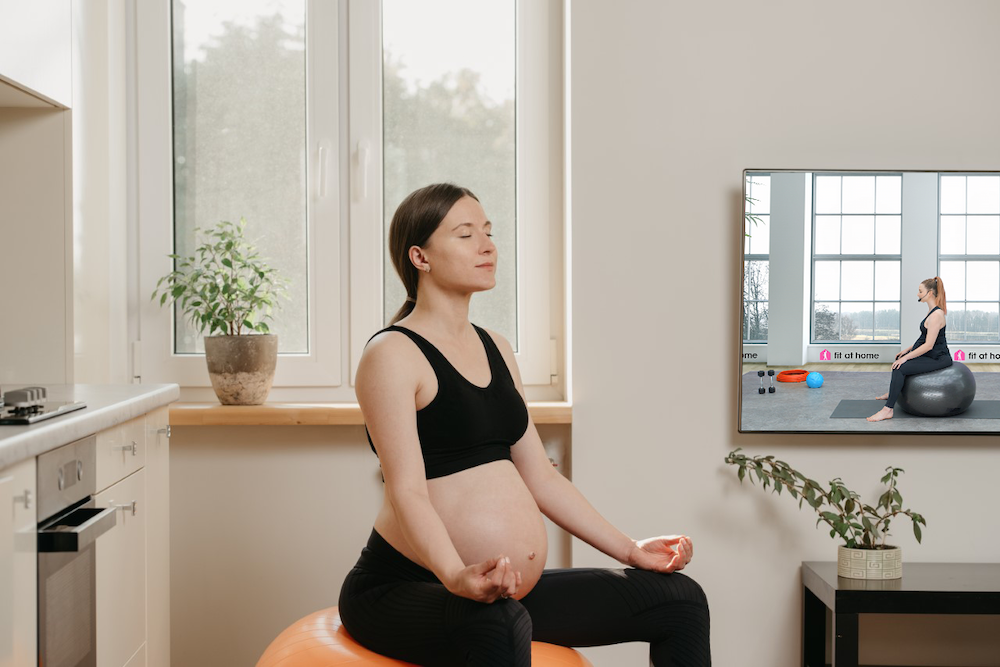Pregnancy is a transformative and exciting time in a woman’s life. While it is important to prioritize the health and well-being of both the mother and the developing baby, there is a common misconception that exercise should be avoided during pregnancy. However, with proper guidance and precautions, working out during pregnancy can offer numerous benefits, both physically and mentally. In this article, we will explore the advantages of exercising while pregnant and provide helpful guidelines to ensure a safe and effective workout routine.

Working out during pregnancy
Exercising during pregnancy can be safe and beneficial for both the mother and the baby. However, it is essential to approach workouts with caution and follow specific guidelines to ensure the well-being of both.
The benefits
- Increased energy levels: Exercise promotes better blood circulation, improving oxygen and nutrient delivery to the body’s tissues. This can help combat fatigue and boost overall energy levels.
- Improved mood and mental well-being: Engaging in physical activity triggers the release of endorphins, which are natural mood-enhancing chemicals. Regular exercise can alleviate stress, anxiety, and symptoms of depression commonly experienced during pregnancy.
- Reduced pregnancy discomforts: Exercise can help alleviate common pregnancy discomforts, such as back pain, constipation, and swelling. Strengthening the muscles and maintaining flexibility through targeted exercises can alleviate strain on the body.
- Enhanced strength and endurance: Pregnancy demands increased stamina and strength. Safe and appropriate exercises can help build and maintain muscle tone, preparing the body for the physical demands of childbirth and postpartum recovery.
- Better sleep quality: Physical activity promotes better sleep patterns by reducing restlessness and improving relaxation. Adequate sleep is crucial for the well-being of both the mother and the growing fetus.
While exercise is generally safe during pregnancy, it is important to prioritize the safety of both the mother and the baby. Here are some guidelines to follow when working out during pregnancy:
- Consult with your healthcare provider: Before starting or modifying an exercise routine, consult with your healthcare provider. They can evaluate your individual situation and provide personalized advice based on your health history.
- Choose low-impact activities: Opt for low-impact exercises that minimize stress on the joints and reduce the risk of falls or injuries. Walking, swimming, stationary cycling, and prenatal yoga are excellent choices.
- Stay hydrated: Drink plenty of water before, during, and after your workout sessions to prevent dehydration. Adequate hydration is crucial for maintaining optimal body temperature and supporting the body’s functions.
- Wear comfortable clothing and supportive shoes: Wear loose-fitting, breathable clothing that allows for unrestricted movement. Invest in supportive footwear to minimize discomfort and protect your feet.
- Warm up and cool down: Prioritize warm-up and cool-down sessions before and after exercising. These help prepare the body for physical activity and prevent muscle soreness.
- Avoid overexertion and overheating: Pay attention to your body’s signals and avoid overexertion. Pregnant women are more prone to overheating, so exercise in a well-ventilated environment and avoid hot and humid conditions.
- Modify and adapt: As your pregnancy progresses, your body’s needs will change. Modify exercises as necessary to accommodate your growing belly and any physical limitations. Focus on maintaining good posture and avoid activities that involve lying flat on your back after the first trimester.
- Listen to your body: Every pregnancy is unique, and each woman’s experience will differ. Listen to your body and adjust your workout routine accordingly. If something feels uncomfortable or causes pain, stop the activity and consult your healthcare provider.
Different exercises at home
Working out is a great idea to stay fit during your pregnancy, but it is really important to realize that you can’t do all the exercises that your used to do. Choose low-impact exercises that minimize stress on your joints and reduce the risk of falls or injuries. With these exercises you will stay active during the day. Suitable options include:
Walking
It is a low-impact cardiovascular exercise that can be easily modified to suit your fitness level throughout your pregnancy.
Swimming
The water provides buoyancy, reducing the impact on your joints. Swimming and water aerobics are excellent choices as they also help alleviate swelling and support the weight of your growing belly.
Prenatal yoga
Specifically designed for pregnant women, prenatal yoga helps improve flexibility, strength, and relaxation. Look for classes or online resources tailored to pregnant women.
Prenatal pilates
This low-impact exercise focuses on core strength, posture, and stability. It can help alleviate back pain and improve overall body strength.
Stationary cycling
Using a stationary bike provides a safe cardiovascular workout without the risk of falls. Adjust the intensity and resistance according to your comfort level.
Create a healthy lifestyle
Staying healthy during pregnancy is vital for the well-being of both the mother and the developing baby. By adopting a holistic approach that encompasses proper nutrition, regular exercise, stress management, and prenatal care, pregnant women can optimize their health and support a healthy pregnancy. Here are some key factors to consider for maintaining a healthy lifestyle during pregnancy:
Balanced and nutrient-rich diet
Proper nutrition is essential for the healthy development of the baby and the overall well-being of the mother. Focus on consuming a balanced diet that includes a variety of fruits, vegetables, whole grains, lean proteins, and healthy fats. Ensure adequate intake of essential nutrients such as folic acid, iron, calcium, and omega-3 fatty acids. Consult with your healthcare provider or a registered dietitian for personalized dietary recommendations.


Regular prenatal check-ups
Attend all scheduled prenatal appointments with your healthcare provider. Regular check-ups allow for monitoring the progress of the pregnancy, identifying any potential complications, and addressing any concerns or questions you may have.
Educate yourself
Stay informed about pregnancy, childbirth, and newborn care. Attend prenatal education classes, read reliable sources, and consult your healthcare provider for accurate and up-to-date information. Knowledge empowers you to make informed decisions and actively participate in your prenatal care.


Stress management
Pregnancy can bring about various emotions and stressors. Prioritize stress management techniques such as deep breathing exercises, meditation, prenatal yoga, and seeking support from loved ones. Engage in activities that promote relaxation and well-being.
Pregnant & Fit
Especially for you at Fit at Home we have Pregnant & Fit. You work out safely with our professional trainer Abby. Abby will help you stay fit and flexible with her special pregnancy pilates.
You can do these workouts at home whenever it suits you. With minimal equipment it is the perfect workout to do for you and your baby.

Stay fit during you pregnancy with Pregnant & Fit
Workout after your pregnancy
Once you have the green light from your healthcare provider, here are some home workout ideas to consider:
- Walking: Start with gentle walks around your neighborhood or in a nearby park. Walking is a low-impact exercise that can help you regain strength and increase cardiovascular fitness.
- Pelvic floor exercises: These exercises help strengthen the pelvic floor muscles, which can be weakened during pregnancy and childbirth.
- Yoga: Postnatal yoga can be beneficial for improving flexibility, core strength, and relaxation. Look for beginner-friendly routines that focus on postpartum recovery.
- Bodyweight exercises: Incorporate bodyweight exercises like squats, lunges, push-ups, and modified planks to work on overall strength and tone muscles. Be sure to start slowly and avoid overexertion.
- Postpartum-specific workouts: There are specialized workout programs designed for postpartum women. These programs typically include exercises that cater to your specific needs, considering the changes your body went through during pregnancy and childbirth.
- Pilates: Pilates can help strengthen your core, improve posture, and promote overall body awareness.
- Dancing: Put on some music and have fun dancing around your home. Dancing is a great way to get moving and lift your spirits.
- Baby-inclusive workouts: Involve your baby in your workouts. For example, you can do baby-wearing exercises or include your little one in some simple movements while you play with them.
- Online workout videos: Many fitness websites and platforms offer postnatal workout videos that you can follow along with at home.
- Listen to your body: Pay attention to how you feel during and after workouts. If you experience any pain or discomfort, stop immediately and consult your doctor.
Remember, every woman’s postpartum journey is unique, so go at your own pace and be patient with yourself. Proper nutrition, hydration, and enough rest are equally important during this phase. Also, don’t forget to practice good posture and lifting techniques, especially if you need to carry your baby or other heavy objects. If you have any concerns or questions, don’t hesitate to seek guidance from a postnatal fitness specialist or healthcare professional.